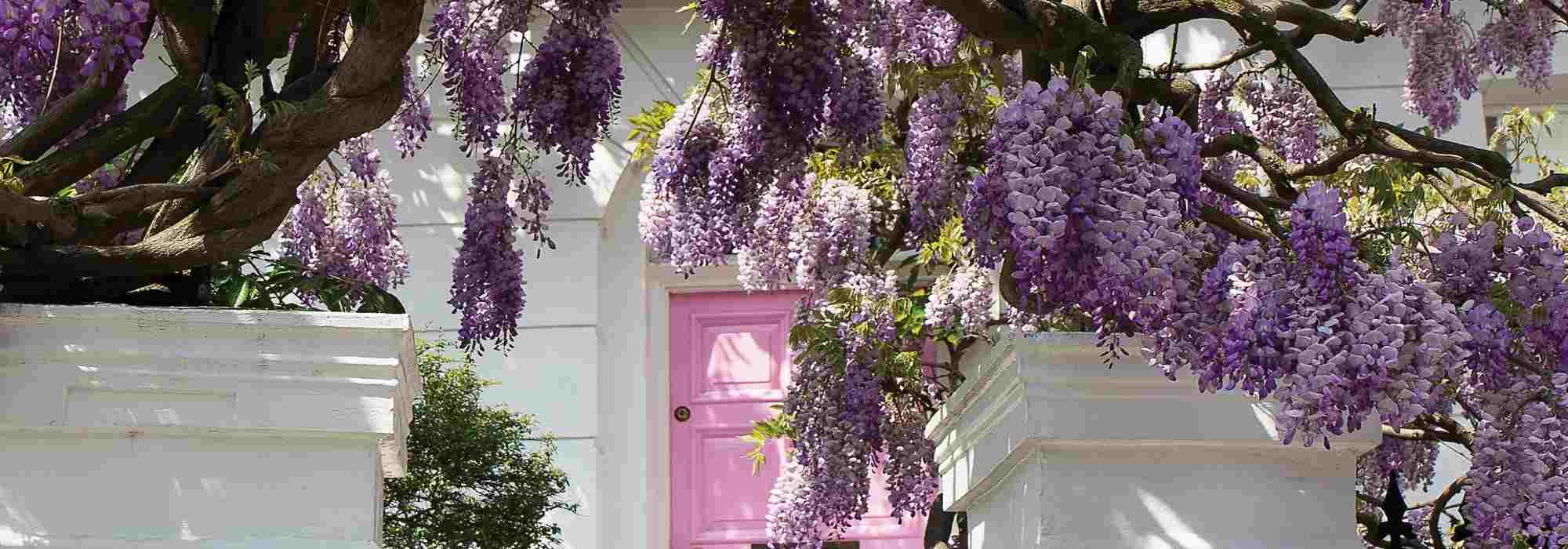
Flourishing an entrance with climbing plants
Transform your entrance into a flower-filled alcove
Contents
The entrance or porch of a house, whether it’s the door leading to the rooms, a gate, or a driveway gate, should be flower-filled and welcoming! Installing climbing plants is a lovely way to envelop your entrance, creating a colourful and often delightfully fragrant passage, adding an undeniable romantic touch. If you prefer evergreen plants to enjoy greenery in all seasons, you might often choose deciduous climbing plants, which are numerous and highly ornamental: roses, clematis, bignonia, honeysuckle…
Depending on your exposure, the atmosphere you wish to create, your favourite colours, the fragrant aspect, the flowering periods, and the plant’s size, you may be unsure which climbing plant to choose?
We help you clarify your options to make your entrance both decorative and easy to maintain!
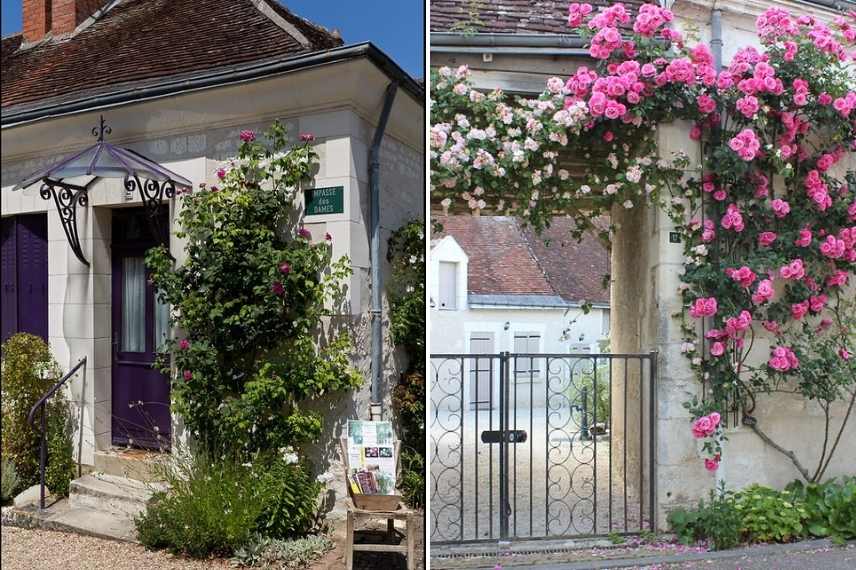
Climbing roses in the village of Chédigny in France (© GK Sens-Flickr)
A climbing plant according to exposure
Of course, one of the first criteria, as is often the case, will be the orientation of your entrance, as you will not install the same climbing plants in the North as in the South. Most climbing plants need sunlight and warmth to produce a wealth of flowers, but the flowering of shade-loving climbers is not lacking in charm and works wonders around an old wooden door…
- a climber for shade: Hydrangea petiolaris and its variations bloom in late spring, around May, offering small, bright white flowers. It has the advantage of being evergreen; the variety ‘Flying Saucer’ is particularly ornamental and compact; Akebia quinata is another very useful climber as it is one of the few that can flower in the shade, with blooms in cream and purple tones that are not eye-catching, and the plant is hardy enough to be planted almost anywhere. Finally, Schizophragma hydrangeoides is also quite useful for dressing a large door, as it takes up space in height and width.
- a climber for partial shade: clematis, wisteria, roses (to the West), honeysuckles, Trachelospermums, and Wattakakas.
- a climber for full sun: sun-loving plants include Campsis, roses, Wisteria, Passionflower, common jasmine, as well as Trachelospermum jasminoides, and in mild climates, Bougainvillea and Solanum. Honeysuckles and clematis will also thrive on a sunny entrance.
Beyond exposure, be sure to consider the hardiness of many lianas, which can vary greatly from one cultivar to another!
Learn more in our article 10 climbing plants for full sun.
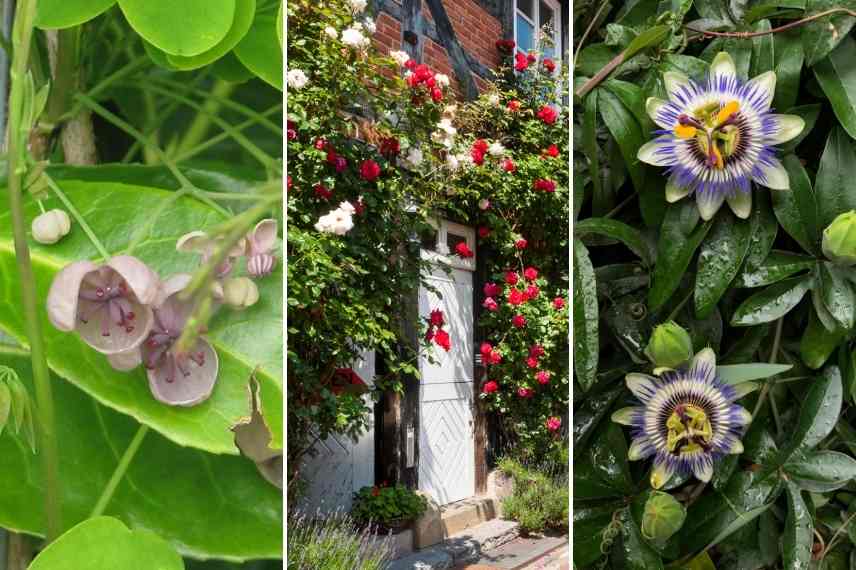
Akebia quinata ‘White Chocolate’ (© Peganum), Roses and Passiflora caerulea
Read also
How to create a welcoming entrance?A climber according to the colour of the flowers
Climbing plants offer a rich variety of colours, catering to all tastes. Choose according to the plant palette near the entrance, or even based on the colour of your door frames that it can harmonise with, or in line with the style of the garden, knowing that lighter shades particularly brighten up shadier areas, while vivid hues may appear washed out in full sun. Here are some climbing plants that we particularly recommend for your home entrance; they are all of medium size for a beautiful framing of your front door:
- whites: immaculate white of Trachelospermum jasminoides, greenish whites like Holboellia latifolia, Schizophragma and Hydrangeas petiolaris, numerous clematis including Clematis ‘Beautiful Bride’, Armandii clematis, the pinkish white of Wattakaka, Wisterias…
- pinks: Numerous clematis, Trachelospermum asiaticum ‘Pink Shower’, Schizophragma ‘Rose Sensation’, Climbing rose ‘Sourire d’Orchidée’ with the charm of a botanical rose…
- reds: some Bignonia, Clematis ‘Rouge Cardinal’…
- oranges: David Austin rose ‘Bathsheba’; numerous Bignonia…
- yellows: Trachelospermum ‘Star of Toscane’, Jasminum nudiflorum, climbing rose ‘Goldfassade’, climbing rose ‘Climbing Max’ (‘Goldengate’), the Bignonia ‘Flava’, numerous honeysuckles…
- blues: the Plumbago and Solanum jasminoides in mild regions, the Clematis viticella ‘Perle d’Azur’, the Clematis ‘Jackmanii’, Wisterias…
- purples: Clematis cirrhosa ‘Lansdowne Gem’, Clematis ‘Ernest Marckham’, Akebia…
- bicolours: Passiflore caerulea, Akebia quinata, Wattakaka sinensis, Climbing rose ‘Hanabi’ for an explosion of colours, the famous rose ‘Pierre de Ronsard’, the Clematis ‘Avant Garde’, the Bignonia ‘Orangeade’, etc.
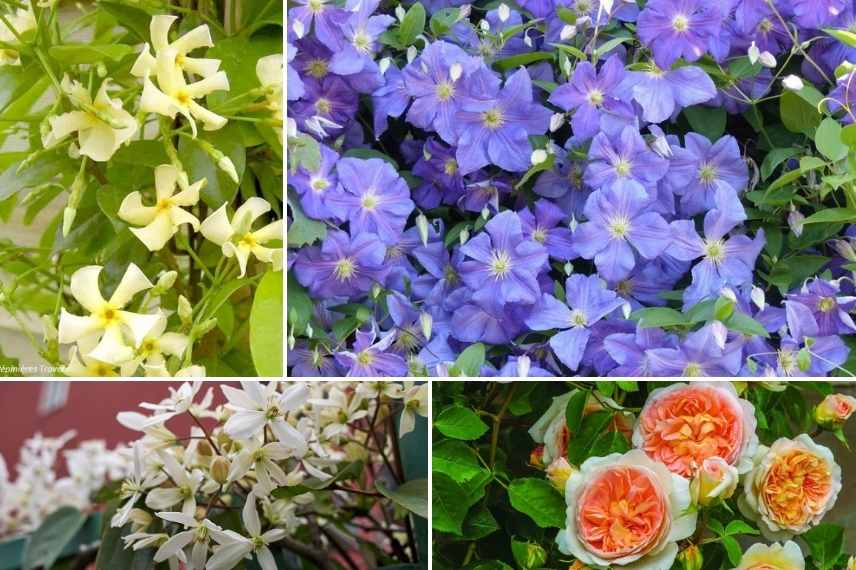
Among the vast array of colours of flowering climbers, here: Trachelospermum ‘Star of Toscane’, Clematis viticella ‘Perle d’Azur’, Clematis armandii, Rose ‘Bathsheba’
Discover other Climbers
View all →Available in 0 sizes
Available in 0 sizes
Available in 0 sizes
Available in 0 sizes
Available in 0 sizes
Available in 1 sizes
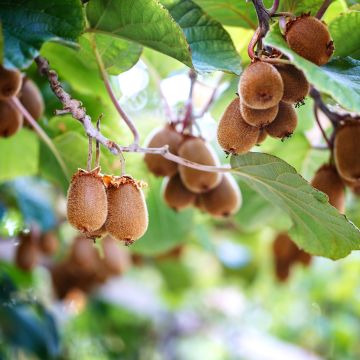
Available in 2 sizes
Available in 1 sizes
Available in 1 sizes
A fragrant climber
Passing under a fragrant plant arch is a wonderful idea to bring not only colours from the flowers but also delightful scents! Don’t hesitate to plant them around your entrance to enjoy the fragrances of jasmine or orange blossom.
Among the top fragrant climbers are roses, of course, but also Armandii clematis (winter-flowering clematis) that exude notes of almond and vanilla, and Cirrhosa clematis with slightly citrusy notes. Trachelospermums offer typical scents of orange blossom, while Arabian jasmine provides heady notes of neroli. The Wattakakas have sweet notes reminiscent of privet flowers, while honeysuckles produce powerful and sweet fragrances, very pleasant in the evening. Wisteria from China (more fragrant than those from Japan) offers honeyed scents, also very strong. Finally, the Akebia quinata ‘Rosea’ provides surprisingly vanilla-like fragrances.
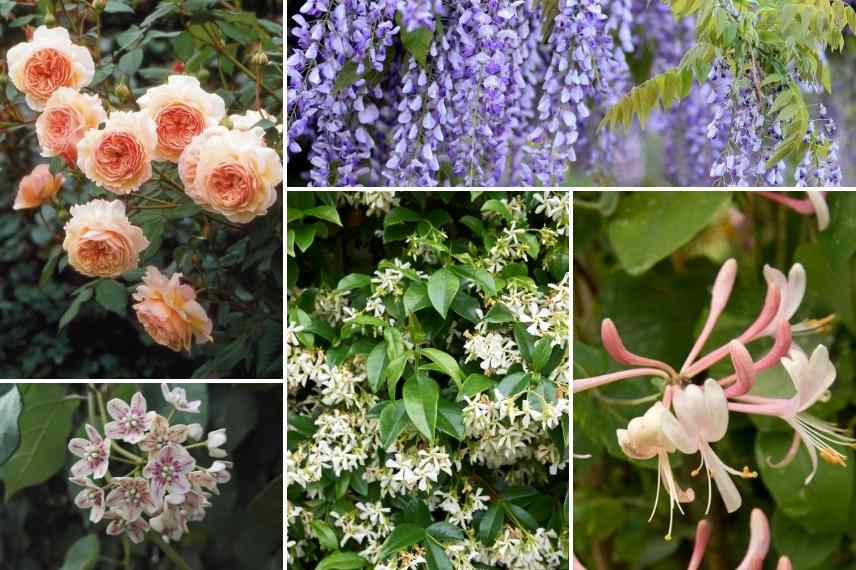
Among the most intense fragrances: the David Austin rose ‘Shropshire Lad’, the Chinese wisteria, Wattakaka, Trachelospermum jasminoides, and heckrotii honeysuckle ‘Gold Flame’
A climbing plant according to the space avalaible
If you need to frame a 3 m wide gate or a small entrance door to your house, you won’t choose the same plant for obvious reasons of size, particularly in height but especially in width, especially since entrance doors are often close to a window that should not be covered. Some very voluble climbing plants have lianas up to 6 or 8 m long, or even more, which are well-suited for installation over wide entrances, such as Wisteria, Bignonia, certain clematis and roses, as well as Schizophragma and Passiflora.
To adorn a smaller entrance, such as a house door, opt for climbing plants that do not take up too much space in width. You might prefer medium-sized roses, or the Japanese Wisteria Wisteria venusta, which has a low spread, or a Jasminum stephanense, which takes up barely 1 m in spread, clematis, etc.
Always check the ground coverage of the climbing plant, so you don’t end up with a plant that becomes too cumbersome for your entrance! Many cultivars among clematis, roses, and Passiflora, in particular, allow for installation around an entrance door.
→ Discover our roses for arches and pergolas, perfect for a small entrance.
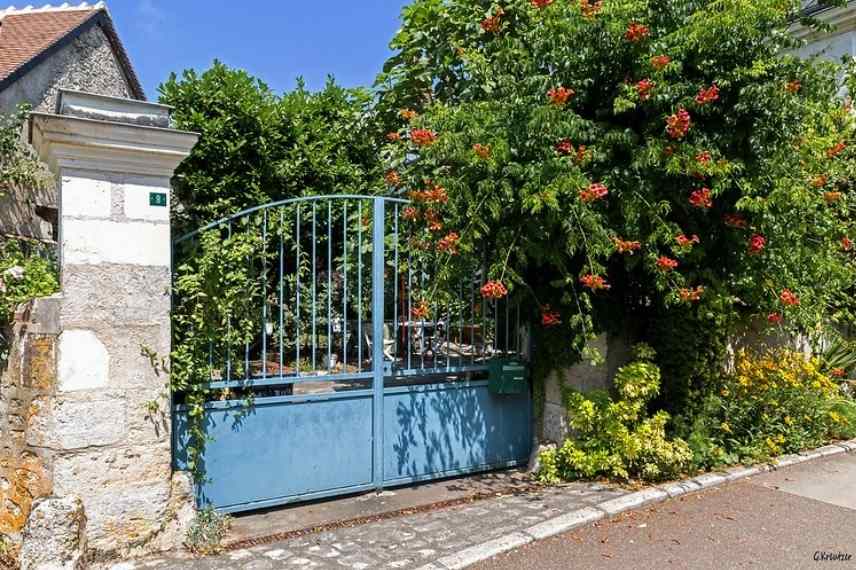
A Bignonia may become invasive, so ensure it has plenty of space (© GK Sens-Flickr)
A climbing plant to suit your mood
The type of climbing plant should be chosen based on the style of your garden, as the strong presence of a climbing plant adds to the personality you wish to convey and announce from the moment you enter:
– In a modern garden, with a contemporary inspiration, don’t hesitate to use original climbing plants such as Wattakas or Holboellias; versatile Trachelospermums will also find their place.
– In an English garden, a cottage or romantic-style garden, charming English climbing roses with a low ground cover, fragrant and highly floriferous, along with Clematis, are a lovely way to welcome visitors.
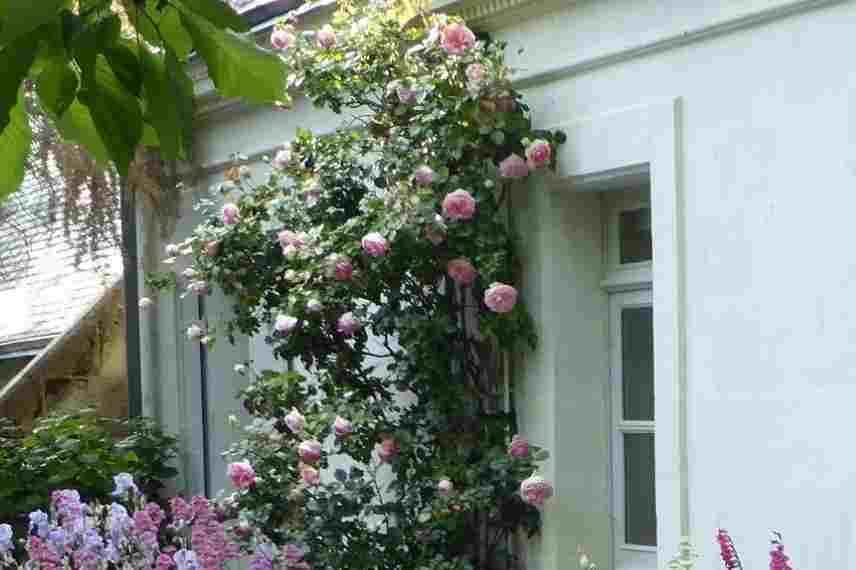
Photo Gwenaëlle Authier David
– In the countryside, one can use a Trumpet Vine, knowing that Honeysuckles, roses, and clematis always blend well into the landscape.
– In an exotic garden, the Trumpet Vine has its place, with its warm colours and tubular flowers bringing the exotic notes of the tropics, but one can also opt for a Passion Flower, or in a mild climate, dare to choose a Bougainvillea.

Trumpet Vine (Campsis) and Bougainvillea, ideal in warm regions to bring exoticism
A climbing plant according to the flowering period
In spring, you have a choice of many fragrant climbers including clematis and the famous Clematis montana, Akebias, and Wisterias. By late spring, Jasmines, Honeysuckles, climbing roses, climbing Hydrangeas, and Schizophragmas take over. In summer, it’s the turn of Trumpet Vine, Wattakakas, and clematis, with perpetual roses continuing their divine flowering. Finally, in winter, the Clematis armandii and Clematis cirrhosa will enchant your entrance, or Jasminum nudiflorum taking up more space around gateways, for example.
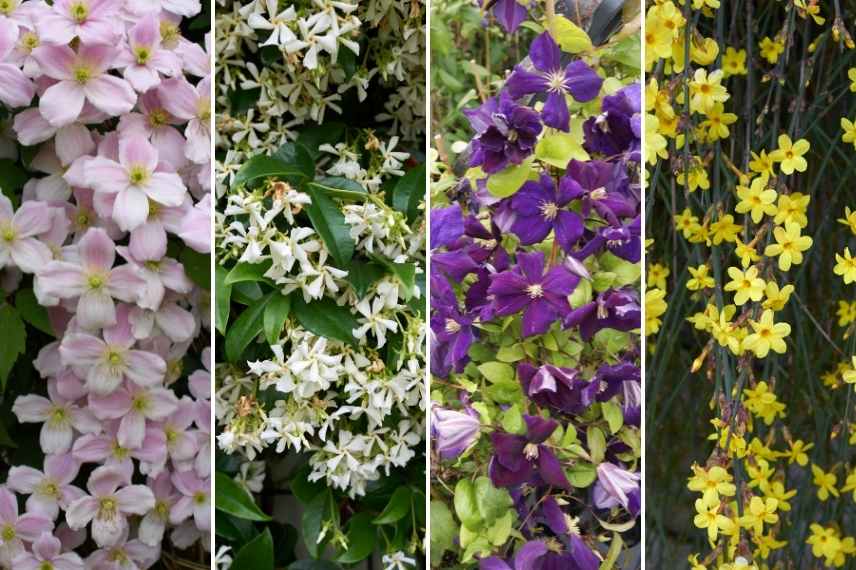
From spring to winter, an avalanche of flowers with Clematis montana, Trachelospermum jasminoides, Clematis Jackmanii ‘Superba’, and winter Jasmine
A climber according to the type of support
You will not install your climbing plants in the same way depending on their support systems, which are completely different. For vigorous climbers like Wisteria, ensure you have very sturdy supports. For a Trachelospermum, use wires to guide it as it does not have tendrils to help it wrap around, just like the Bougainvillea. For a rose or a clematis, a crossed trellis will be sufficient. The Bignonia and climbing Hydrangea, on the other hand, can cling on their own.
A unique climbing plant or a combination of climbing plants?
It’s a question worth considering before installing a climbing plant around your entrance for many years. You can install the same climbing plant on both the right and left of a gate or entrance to create a lush green archway that is very appealing when entering a home. Alternatively, you can frame a door with two different climbing plants, either in colour or type. It’s all a matter of aesthetics.
You can thus pair a rose with a clematis in a very classic yet charming way (for example, the Climbing Rose ‘Trier’ with its lovely small cream and yellow flowers alongside the Clematis ‘Star of India’, or two clematis of similar colours together (one white and one mauve, one pink and one white, etc.). Clemmatis are particularly well-suited for this type of combination as many of them have a lesser spread in width and will provide a beautiful overall visual around the door.
For a larger span around a gate, such as on either side of a porch, it is preferable to install the same climbing plant for a lovely mass effect. Evergreen climbers like Winter Jasmine are ideal for the South, while Hydrangeas petiolaris are perfect for the North. The Wisteria, although deciduous, will be perfect for a grand entrance due to its stunning spring flowering, which continues in summer, and its long foliage that provides privacy until late autumn. The Trumpet Vine is a beautiful option to accompany a large gate with its warm tones all summer long!
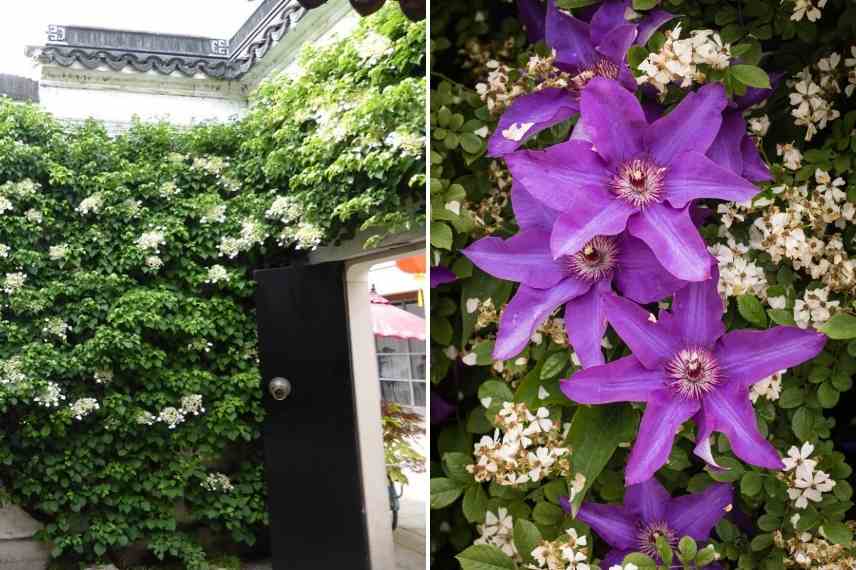
On the left, an impressive Hydrangea petiolaris (© Wendy Cutler), on the right, a beautiful combination of purple clematis with large flowers and a botanical rose with white flowers
Care and maintenance
Your entrance should be welcoming, but also secure! Be cautious of certain old roses that drop a lot of petals on the ground; during rainy weather or when you prune them, they can become quite slippery. A wisteria located near an entrance door will also shed many clusters of flowers after the peak of flowering, as well as a significant amount of leaves starting in September. You will need to sweep your entrance regularly… Finally, bignonia, like wisteria, can become very voluble, so you will need to prune them regularly if you don’t want to be overwhelmed or create too much shade near a window, for example.
- Subscribe!
- Contents
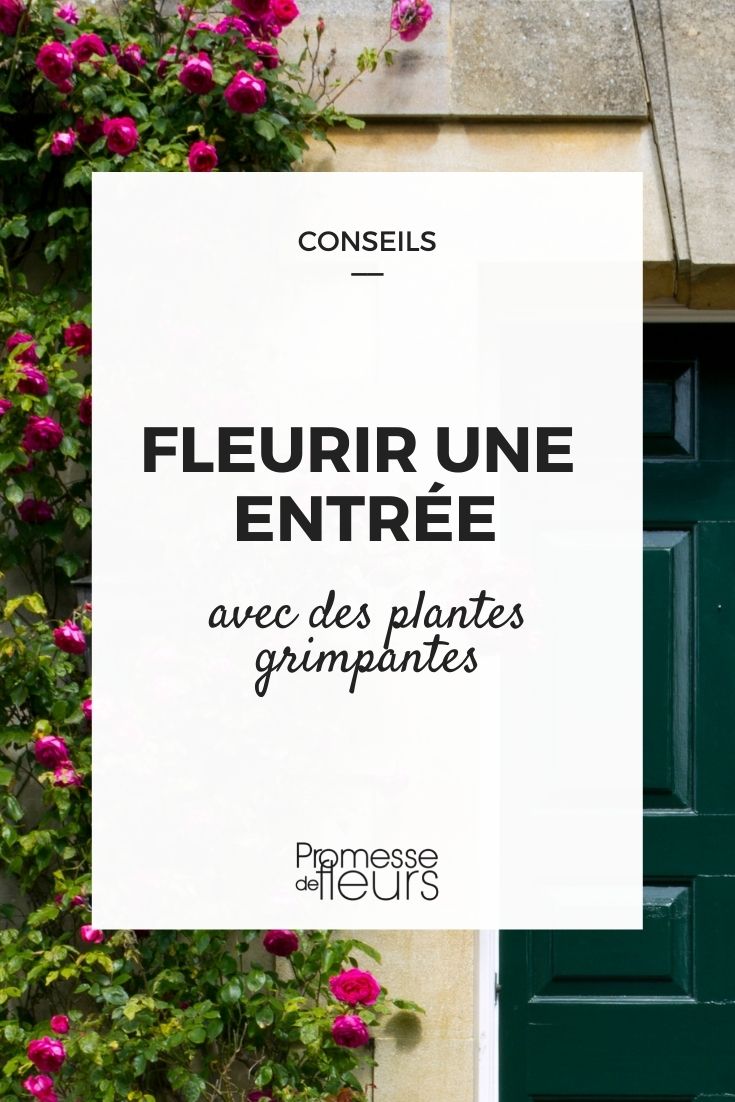































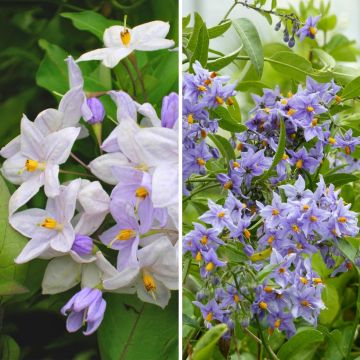
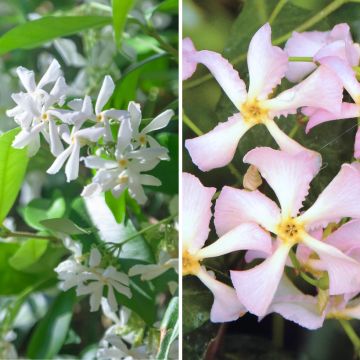

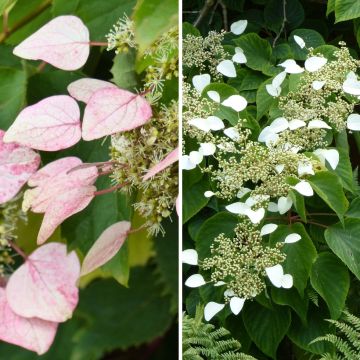
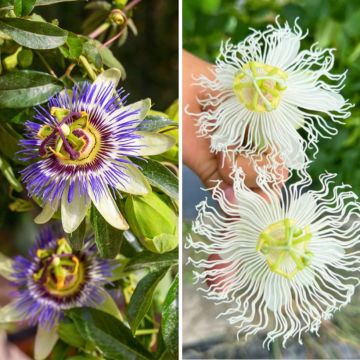

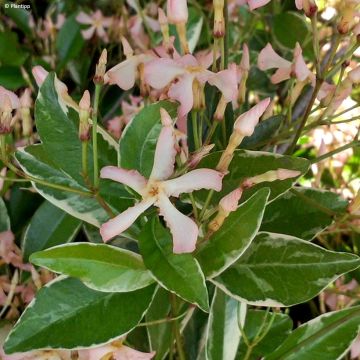
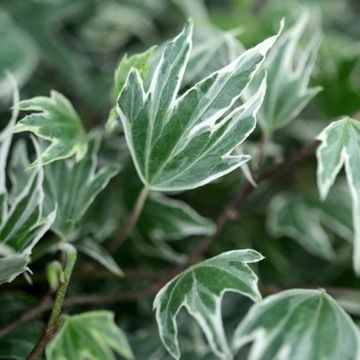
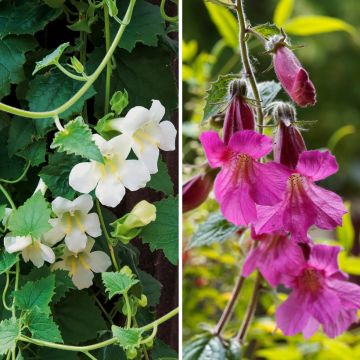
Comments